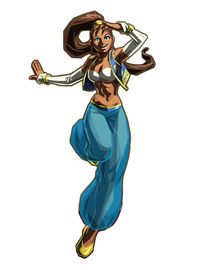Fight! Round 2 by Doresh
Basic Qualities, Qualities, and Techniques (Blaz, the Blueing)
Original SA post Fight! - Round 2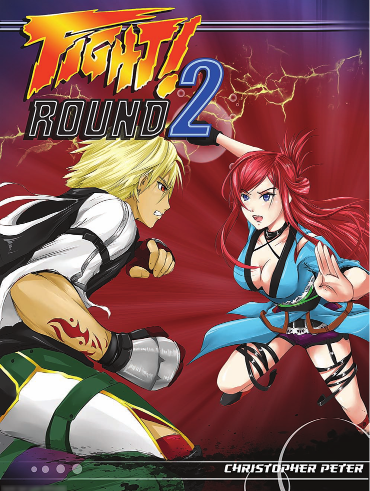
Looks like Rock Howard got himself a new outfit.
Chapter 1: Basic Qualities, Qualities, and Techniques (Blaz, the Blueing)
Fight! was one of the first RPGs I've covered here, so let's take a look at the supplement. But first a little refresher:
Fight! is a RPG meant to capture the spirit of fighting games, similar to the old Street Fighter: The Storytelling Game or Thrash. Unlike those two, Fight! is a lot more effects-based (aka the game doesn't care if you're the only dude with armor and a sword; that probably just means that you're slow, durable, and hard-hitting), and instead of trying to adapt the general concept of fighting games into your standard RPG, it instead tries to essentially emulate fighting games through dice rolls: There are combos and hit stun, the "map" is just a one-dimensional grid, and even duels to the death are fought out in typical best-2-out-of-3 structure (though that doesn't actually happen in-setting. Rounds just break up the fight for narrative purposes). Also your Special Moves' relative strength can me correlated to their hypothetical button inputs, which is pretty helpful for conversions.
And if you want to get really crazy, you can treat the characters and everything like a video game. Your Fighter aka player character can totally have a crappy sprite, or an awesome theme.
Probably the most unorthodox thing Fight! does is make combat more unpredictable: Not only is your Control (which is best described as "How much time you have to input moves and combos") rolled each round (with most modifiers being die shifts), but the amount the timer (of course there is a timer) decreases at the end of the round is also rolled, which can be pretty important if you - or your opponent - have buffs going on, as they care not about rounds, but about timer counts.
It's a bit like a mashup between Hybrid Heaven and Grandia 2, to use a completely different genre of video games.
The game is not without its oddities. The layout could need work, and some of the terminology can be confusing at first (there are "Basic Qualities" which are stats, but also just "Qualities" that are advantages). Getting into the combat rules - the meat of the game - can also seem a bit daunting, but there's the optional Dramatic Combat system that streamlines things while giving you additional things to do in combat besides hitting dudes. It's basically less Street Fighter and more Street Fighter: The Animation.
Now most of the pages of the corebook were taken up by Elements and Liabilities (the stuff you bolt onto your Special Moves) and lots of optional rules to tinker the "engine" to your liking. This book has a lot more where that comes from, many of which are directly inspired by games such as Samurai Shodown, Guilty Gear and Mortal Kombat.
So, let's get ready to rumble!
Basic Qualities
Round 2 introduces two options to tinker with the Basic Qualities, aka the stats of the game. One of them is about Speed, a stat that fuels two sub-stats: Initiative which is pretty self-explanatory and Control, which affects your base Control Roll. Each increase or decrease of Speed only affects one of those sub-stats. The optional rule let's you further deviate from each other, so you can have a very fast guy that can most likely only pull off simple moves or combos, or a slow grappler who can do 360°s all day.
There's a bit of warning for potential abuse however, since unlike Initiative, Control can actually gain static bonuses as you level up, making it tempting to always go for higher Initiative.
The other optional rule removes Ki as a Combat Skill. Ki not only determines how good you are at cancelling enemy Hadokens with your own Hadokens, but also the damage they do. You can also use an Element to apply your Ki damage to a normal Special Move, which is how you get Ken's fiery Shoryuken that is just better than Ryu's.
The optional rules basically boils down to turning Ki into another Basic Quality akin to a situational Strength. This streamlines things and makes Ki more consistent across the campaign (heavy Ki users can be pretty scary later on, but then again the points put into Ki are missing somewhere else), but it leaves the option for a dumb stat if you don't care about ranged attacks.
New Qualities, Weaknesses and Quirks
Aka advantages, disadvantages and, well, quirks. There are not a lot here, but they're quite fun:
Stage gives your Fighter a pretty neat stage. Should you find yourself fighting on your home turf - or in an area that looks similar enough - you gain slight Fighting Spirit (kinda sorta combat-only Fate Points / Willpower, except used much more often and available in bigger quantities) regeneration. This is again tied to the random timer count, which means you will want to draw the fight out, while the other guy will probably want to KO you ASAP.
New Weaknesses give us Deficiency (your like Guilty Gear's Potemkin in that you lack options available to everyone else, like say double jumps) and Hidden Abilities (you're like Tony Stark, Kamen Rider or Sailor Moon in that you need to henshin it up before you're at full fight capacity).
The Quirk Sexually Ambiguous makes you androgynous to the exreme. Just like say Shion from King of Fighters XI, nobody is sure just what you are.
Techniques
Techniques are a bit like combat feats in that they offer little options for your Fighter, like say the ability to do a back dash or a wall jump. Some Techniques are set as the default for the campaign, while each Fighter can add further ones through their repertoire with the Technique Quality (or remove ones with the above Deficiency).
Delayed Wake Up revolves around one of my favorite bits of source material emulation. You know how getting knocked down in a fighting game makes you pretty much untouchable until you stand up again? This is trze in Fight!, right down to the part where your character has to stand up again if it's his turn again. This Technique let's you stay down for longer, though you can't really do anything while you do so. But don't worry about characters surviving all-out brawls because they laid down and played dead, cause this supplement also introduces some of those rare ways to hit a guy that is knocked down.
Fury Mode simply makes you hit harder if your Life Bar (aka Hit Points) are low. A variant turns this into the T.O.P. system from Gaoru: Mark of the Wolves, letting you "move" this damage boost to the start or middle of your Life Bar and increase or decrease the boost istelf based on how big of a percentage it covers.
You can either have it like in Garou where you can change up your Fury Mode "setting" before a fight, or you can make it permanent. I especially like the idea of a character who has that permanently in the middle: He feels the need to give it his all when he appears to be losing, but then it fizzles out when he notices that he probably is going to lose.
Pre-Set Combo is for characters who have fixed chains of moves that easily flow into each other. Fight! normally doesn't care about this level of detail (many fighting game characters would have way too many of these pre-set combos), but you can use this anyways if everyone's on board with it. This lets you create a pre-defined string of Moves that are treated as a single Move for combo purposes, letting you make combos within combos.
Super Armor and especially Hyper Armor make you more resistant to damage and Hit Stun, while at the same time making you less mobile. The former can be used for really big characters, while the latter is so extreme it should only be used as a Temporary Technique (aka one you gain from a specific move that lasts till your next turn). This is basically Street Figher 4's Focus Attack, which lets you eat a hit from the enemy and keep going, damage be damned.
Campaign Based Techniques
This rule gives every Fighter in the campaign access to a unique kind of Technique for free, one that can have a pretty strong impact on the Fighter's overall combat style. This rule requires a lot of work for the GM to make up new Techniques and ensure that they are roughly equal.
If you're familiar with BlazBlue, this is pretty much entirely based on that series. The example Techniques are even based on BlazBlue characters: You can curse the opponent and hit them with all sorts of stuff from every direction (Arakune), manipulate wind or gravity to your advantage (Rachel Alucard), gain a permanent tag buddy that owns a good chunk of your move set (Carl Clover), or use the power of chains or magnets to keep the opponent close to you (Iron Tager).
Overall a cool option, but this requires quite a bit of houseruling by design because this stuff can do just about anything.
Next Time: Basic Moves - air dashes and more!
Basic Moves (Fatal & Furies)
Original SA post Fight! - Round 2
Chapter 2: Basic Moves (Fatal & Furies)
This chapter is all about movement, attack and other kinds of action that can serve as the baseline for what everyone in the campaign can pull off.
Modifying Basic Moves
First up are rules for diversifying Basic Moves. In the corebook, there's only one Basic Move, meant to cover everything from a light punch to a heavy kick depending on the Fighter's style, the circumstances and the damage roll.
The first option is about dynamically adding an Element to your Basic Move, increasing its Control in the process. This let's one handle basic attacks with a variety of properties seen in video games, like say a punch that is good against aerial targets, or far-reaching kick. This gives Fighters more tools to use (and expect from opponents), but can steal the limelight from Special Moves if the GM allows too many of these Elements to be used.
If having just one Basic Move is not enough, you can also get yourself a Light Basic Move (weaksauce damage, but good recovery) or a Heavy Basic Move (which is basically a simple Special Move you get for free).
Modifying Jumps
Jumps are one of the most basic ways to quickly cover distance to the opponent, at the risk of getting shoryuken'd in the process. This section offers variantes like Double Jumps, Super Jumps and Wall Springs, all of which are about getting defensive bonuses and/or better positioning.
Advanced Grappling
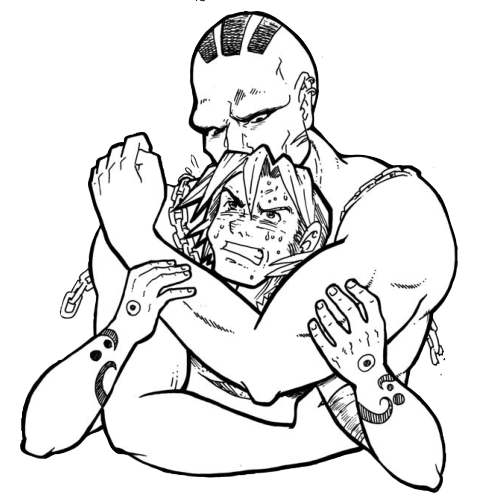
This is what reading Beast feels like.
Throws and grapples are handled pretty basic compared to the nightmare that is oldschool grappling roles in RPGs, just like in the video games. The range is short, but they're hard to evade.
This section adds some more versimilitude to Throws, evoking the feel of many wrestling games. Instead of just pulling off a Throw normally, you can instead turn it into a grapple. This puts you at the risk of the opponent escaping, but if everything works out you can move him around a little, after which you can either finish the Throw or essentially "cancel" into three other options: increased damage, increased stun or some more moving around.
Command Moves
These are effectivel L2 Special Moves, aka stuff that would require 2 or so buttons to pull off in a game, like say an uppercut or a dash. The corebook only had a few of these as guidelines, and here are a bunch more.
Air Dashes, as seen in many anime-inspired fighting games, are an alternative to normal jumps. It has additional defensive properties, but can't directly pull an attack or combo out of it like with a normal jump.
Another jump alternative is Run, which covers the same distance, but obviously protects you from anti-air attacks. Has a slight Control penalty through, so combos out of a Run aren't quite as long.
Sidestep on the other hand is an alternative to Evasion, and popular with 3D fighting games. The main difference is while a successful Evasion lets you move around, the Sidestep instead nudges the opponent closer to an environmental hazard of your choosing, to say prepare a ring-out.
Also presented her are additional ways to do Power Ups. The one in the corebook lets you forfeit your attack in order to gain additional Super Energy fo those sweet Super Moves. In a fighting game, this would be the equivalent of a dedicated charge command like in DBZ, or the old tradition of attacking the air with fast Special Moves.
Thes Power Ups here mostly deal with temporary buffs, either through increasing damage or adding an specific Element to a specific Special Move. These are mostly meant to be used on a per character basis.
Fans of Guilty Gear will probably be familiar with the Burst Assault. This Move has its own energy bar to limit its use, and it can interrupt enemy attacks while maxing our your Super Energy. Fans of King of Fighters will like the Power Strike, which is basically a Blowback Attack (aka a basic attack that knocks the opponent away and to the ground). And if you're into the DBZ games, there's Close Combat, which has the Fighters trade blows for a while till one comes out on top in a contested Control roll.
If you really, really want to knock your opponent down with now fancy breakfalls or anything to get in the way, there's the Tackle. That one also becomes unblockable if you get a running start, which is pretty sweet to use against turtlers seeing how the Unblockable Element is one of the pricier ones out there.
As mentioned last time, you're pretty much invincible if your knocked down. Here are a few options to do something against that, which is mostly seen in 3D fighters. You can use a dedicated Pursuit Attack to hit a downed foe, or alternatively use any of your normal Moves at an Accuracy penalty. You can even pick him up for a throw. And you can follow up the above Tackle by Beating the crap out of the poor opponent, which unlike a Pursuit Attack can actually be used as a combo starter.
A downed Fighter can react with all of this by either attacking while still being on the ground (the Ankle Kick) or attacking while standing up (the Recovery).
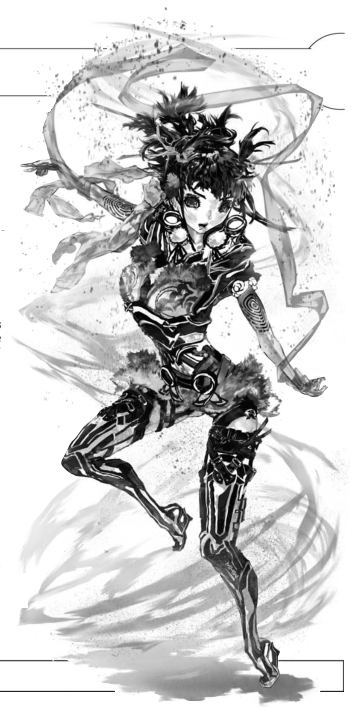
I'd like to see a fighting game made by Vanillaware.
Next Time: Special Moves - time to buff up.
Special Moves (Gear: The Guilty)
Original SA post Fight! - Round 2
Chapter 3: Special Moves (Gear: The Guilty)
Special Moves are heart and soul of every Fighter. Built from the same baseline and customized with Elements and Liabilities, they shape your entire fighting style. So it's always nice to have more customization options. There are quite a lot here, so this will probably be the longest entry.
The chapter starts of with a little options for Moves for which you can't seem to fill out all slots, which can happen if you're converting a pure support Move that doesn't deal. You can either fill out the slots with stuff like the Increased Glory Element for some extra XP, or reduce the overall cost of the Move. Again, mostly for converting stuff 'cause you can just decrease the Level of the Move for your original creations.
New Special Move Liabilities
This wonderful section starts off with what might be my favorite Liability: Cheap. This metagame Liability causes the campaign's fictional fighting game community to consider the Move broken and cheesy. As such, you gain no Glory from using it the first time, and additional uses will actually cause you to lose Glory, because only cheaters spam that stuff.
The GM can also force the usage of this Liability for Elements or Element combinations that have gotten a bit too overused during the campaign. This could qualify as antagonistic GM behavior, but it seems to be a rather mild case - unless you're that one guy who adds Easy to Combo and Fast Recovery to every single Special Move you make.
No Defense and No Movement apply either to all Moves in a Style or a Move with the Buff Element (more on that one later). They do exactly what they sound like and limit your options while you'r under the effect of the Buff or in that Style. Inspirations for these two are probably Hotaru Futaba in her post-Garou appearances, and a lot of characters from Virtua Fighter.
Another modifer to a Style is Modified Defense. This lets you have a different distribution of your defensive Skills in a Style, reducing Defense (blocking stuff) in favor of Evasion (avoiding stuff) or Tactics (countering stuff). This lets you make a Fighter who has a Drunken Master Kung-Fu stance that causes him to move unpredictably (Evasion), or a very focused counter stance (Tactics). Could also work for a couple Kamen Riders.
Requires Environment Hazard, as you might guess, forces you to be close to a specific type of Environmental Hazard. This pretty much solely exists for wrestling moves that require ropes and corners and stuff.
Sidestep Setup is very common for 3D fighting games. You can naturally only use the Move after having sidestepped before, aka evades without moving away form the opponent.
Slow Startup is for those Moves that have a slow startup, but you can't quite bring yourself to just reducing the Accuracy. The Move requires more Control to use, and it can't be used at all if your opponent's Iniative is too close to your own.
On the one hand these drawbacks are kinda hefty compared to just buying a Move that's one Level higher, but if you have the Control to spare, and there's a consitent gap in Initiative between you and your opponent, you might barely notice this Liability. I like that.
Specific Range is for those annoying Moves that will just plain miss the opponent if you're too close to him. Can probably be pretty fun to make a "puzzle boss" that can do completely different stuff depending on the distance.
Vulnerability is a pretty nice risk-reward deal: You basically enjoy a free slot for your Move - unless the opponent has higher iniative and decides to wait with his action to interrupt you, in which case you suffer increased damage from that attack. A more severe version turns this extra damage into a short debuff, encouraging both opponents to mess around with the timer.
New Special Move Elements
Here we get completely new stuff, as well as modifications to existing Elements.
The Bomb Element, which creates a bomb that detonates after a while, gets some new options. You can have multiple bombs out at the same time, make it so they only detonate on command, have to shoot at an opponent, or have them not explode at all so shooting is all they do, like Dizzy's floaty bit thingies.
Temporary Invulnerability from the corebook is a nice and pricy Element that heavily discourages opponents from trying to interrupt or counter you. If you want a Fighter that is all about that stuff and fear getting curbstomped, you can now get the Breaker Element, which ignores those pesky invincibility frames. This Element is pretty much for those moves in Street Fighter 4 that just power through Focus Attacks.
The main downside of Throws has always been their short range. You can build a Special Move with more range that has all the effects of a Throw, but the Throw Element has all of that at a discount. For an alternative option, you can get the Cancel Throw Element. When using a Move with this Element just out of Throw range, you can try a Tactics check to instead cancel into any Throw you have. I think that's a wrestling thing?
Not really an Element but more of an optional rule, the GM can decide that counters can be countered, so you can counter while you counter.
Create Environmental Hazard is pretty much like the Bomb Element, except you create stuff like pits or walls. If you want, those walls can also be on fire or electrified, or you can use them to reflect projectiles back at the attacker.
Before you decide to go crazy with this or the Bomb Element, you should know that these Environmental Hazards can take a bit to wrap your head around, as the abstract map causes each of them to have a different distance from every Fighter. It's best to visualize this as each Hazard adding another lane to the battlefield.
On the plus side, if you own Reiner Knizia's wonderful Lord of the Rings board game, you can use the boards from that game to play Fight!.
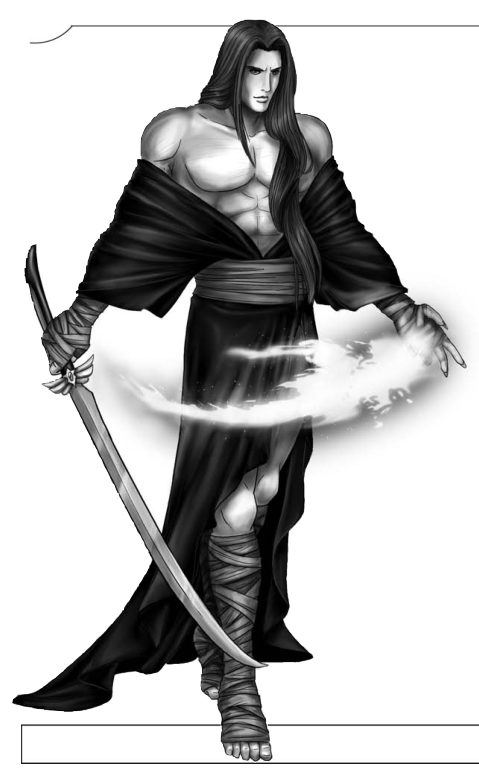
Not sure if Soul Calibur, or Samurai Shodown.
The Evades Ranged Element from the corebook is sort of a newbie trap. Used to not get hit by a ranged attack, one could get the idea that it allows you to get closer to the opponent. Defensive actions however don't let you move around unless they specifically say so, so this is less like Cammy's "duck under projectile and punch the Shoto in the face" move, and more like Zangief's "Spin in place and let the projectile somehow pass through you" moves (I'm terrible at remembering these). It can hit the opponent, but only if he was already within range.
But fear not! With Move Before Attack, you can finally be like Cammy.
You can now also improve Knock Downs to disallow the downed opponent from doing fancy stuff like Breakfalls and Tech Rolls. If you want them to stay down, you can now make sure of it.
The Mobile Element, your go-to element to keep the action close and personal, also gets some new toys to play with. If your Fighter can Wall Spring (either because he bought the ability to do so or everyone in the campaign can do it), you can get a version of Mobile that only works if you can Wall Spring as part of it, though you get extra Accuracy as a compensation.
If you really need to cover lots of distance, you can add the Full Screen Element. Though note that the opponent gets a defense bonus if you have to cover the full range (because he can see you coming from a mile away), unless you add another Element to so you can go faster.
Multi Hit is an alternative to Increased Damage. Instead of increasing your potential maximum damage, you instead increase your minimum damage. This is obviously meant for Moves that hit several times as part of their animation, but you're not required to use it.
Power Dash on the other hand increases your damage when you've just dashed.
Power Enhancer from the corebook is an Element meant for Jam Kuradoberi, who has utility Moves that boost some of her actual attack Moves. In Round 2, you can customize this further by not only boosting the damage, but adding new Elements to those moves. So you could boost a Move to knock the enemy away and down.
Power Up also from the corebook let you boost damage by either paying more Control (charging up the move) or damaging yourself. Just like with Power Enhancer, you can use the former option to also add specific Elements. This is for characters like Yuri from Art of Fighting and King of Fighters, who in some game appearances can turn her short-range ki blast into a full-range projectile by charging up for a bit.
Since Power Up is a bit more dynamic than Power Enhancer, you have to write down what the Move does dependin on how much Control you throw at it.
Pursuit is the Element for Moves meant to hit downed opponents, like say Geese Howard's electrifying grab. An interesting modifier to this is the Pursuit Bounce, which hits the downed foe so hard he bounces up for a possible juggle.
The Ranged Element from the corebook already featured the Draw Closer Element for all your "Get over here!" needs. Round 2 features an Element that prevents the move from drawing the opponent closer if you don't want to. You can also add an Element that causes your Fighter to get cloesr to the target instead. This doesn't actually change anything in a simple 1-on-1 duel, but has its uses if multiple Fighters and Environmental Hazards are involved.
Wall Bounce causes the projectile to bounce off walls to make it harder to avoid.
Set Up is for Moves that need to be prepared in order to be used. The Move doesn't do anything when used once, but a second use later will add extra Accuracy to the attack. This is pretty much for characters like Testament who are big into setting up traps, without having to worry about Environmental Hazard rules. This Element can be further modified by limiting access to the rest of your move set while the Move has been set up, but not used. You can even have Moves that are only usable during the Set Up.
Basically this is an alternative to giving your character different styles. You can for example build a swordfighter who can ram his sword into the ground, beat people up with Kung Fu and then cause the sword to boomerang back to you.
Triggered Interrupt is the defensive cousin of set Up. Instead of setting up an attack in advance, you instead set up a counter in advance to act as an extra layer of defense. These are basically the spiderwebs Testament likes to create.
Sidestep Counter is just that, a counter that involves sidestepping. Best used for ring-outs and similar environment shenanigans.
Skips Knock Down causes the Move to deal no damage. Why would you want to use it, then? Well, it can cancel out Knock Down effects, allowing you to use a Knock Down Move in the middle of a combo.
Holy crap, this actually is a Reset.
Summon is Zappa and Zato-1/Eddie, the Element: you summon a tag buddy that moves with you and hangs around for a while or until you're hit. This summon can't be attacked by an opponent and essentially acts as an enhancer to your normal attacks. If you use a Basic Move, the summon will do so, too. Further Elements to the Summon Move don't do anything for the Move itself, but instead provide a pool of Elements the summon can slap onto its Basic Move, one at a time. If you can avoid getting hit and keep the time count low, this is a pretty scary rushdown tool.
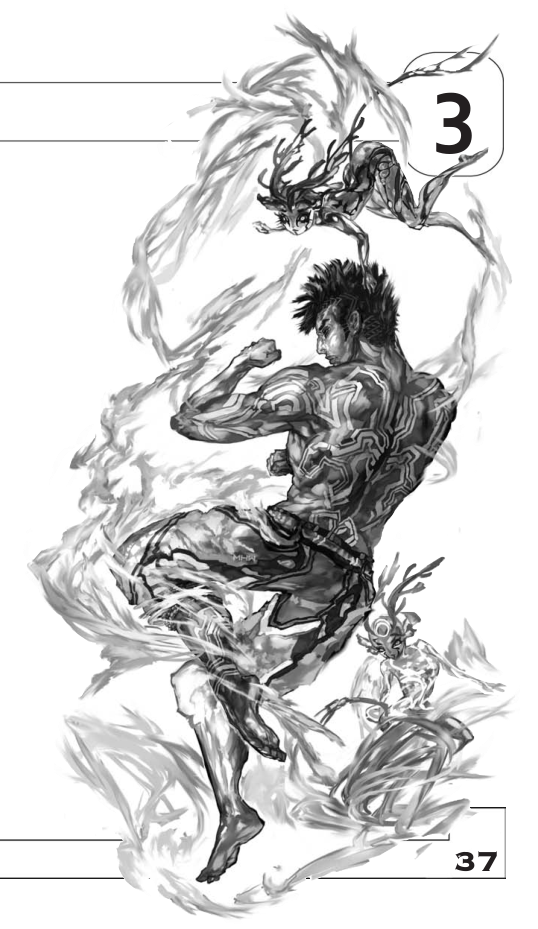
True martial artists find a balance between badass and whimsy.
Super Counter is a bit like the Throw Element in that it is a cost-efficient package of other Elements. In this case, it's a Move that can only be used as a counter, costs Super Energy to be used and knocks the opponent down without a chance to Breakfall or Tech Roll. If you've played Street Fighter Alpha 1-3, this is pretty much an Alpha Counter.
Super Energy is a nifty Element for flashy fighters in that it generates more Super Energy than other Moves on a hit.
Suppression from the corebook is a pretty scary Element that can cause the opponent to temporary become immobile or unable to use Special Moves. Round 2 lets you throw additional Element slots to further boost the latter effect. Want the opponent to also be unable to user Super Moves, or even Basic Moves? You can do that. Want to have the opponent be temporarily incapable of doing anything aside from dodging your attacks (like say after polymorphing them into a small animal)? You can do that, too. Pretty costly, but just as lulzy.
Weapon Break is a very specific Element meant to evoke Samurai Shodown (specifically the 2nd game): It can only be added to Super Moves and is only allowed in campaigns where everyone has a weapon, aka just the right kind of campaign to benefit from more weapon-specific rules. This nasty Element - as you might've already guessed - breaks the opponent's weapon, forcing him to rely on Basic Moves (which now deal less damage) for a while until a replacement weapon is thrown into the ring for him to pick up.
Wind Up is for characters like Balrog who can keep a Move buffered in the background by just holding down a button. Instead of using the move directly, you can decide to delay it. The longer you wait before actually using it, the more damage it will deal. As a downside, any Move you do in the meantime costs additional Control (it's awkward to keep fighting while one finger and button are on lockdown).
Buffs
This one's so big it gets an entire section on its own. It's what happens if you pick the Power Enhancer and Style Changer and crank it up to 11.
Best suited as a Super Move because of all the slots it can take up, the Buff Element lets you radically alter your Fighter. You can not only alter your defense like the Modified Defense, but you can also alter your Basic Qualities, switching points around or just straight up increasing all of them. And not only can you add Elements to Moves, but you can also switch them out for new ones, which lets you essentially replace a Special Move.
This is pretty much the Element of choice to make something like Sol Badguy's Dragon Install, or other cases of going Super Saiyan.
There's also a bunch of different modifiers to Buff to get just the right kind of Buff you want: Normally the Buff is only temporary. You can make it last for the rest of the fight if you throw enough additional Elements at it, but this will cause you to constantly lose Fighting Spirit, which can get you into trouble if your opponent survives long enough.
Alternatives to the normal duration tie the Buff to either your Super Bar or a dedicated buff Gauge. You can also make the whole thing cheaper by adding stuff like "You lose Life Bar each turn" or "You become stunned at the end of the Buff".
And if you want Super Saiyan 2 or even 3, you can make a cumulative stat booster Move. Can't be stacked up more than 3 times (no Super Saiyan 4 for you) and there's a hard cap as to how high your Basic Qualities can get, though you'll still be very scary. This is the only way to increase those Basic Qualities, after all.
If that wasn't enough, you can add an Element to a Special Move that lets it end a specific Buff early, which would be most helpful for Buffs that drain your Super Energy or Life Bar.
Adding Liabilities to Attack Strings
Attack Strings are Fight!'s way to emulate 3D fighting game's love for huge list of combos with unique effects without actually having to bother with the huge list. You instead can make combos consisting of Basic Moves where you can trade in hits for Elements. Also you can make combos out of combos, which is always fun.
With this optional rule, you can cancel out these Elements by choosing from a small list of Liabilities. So you could make an Attack String that causes the opponent to bounce, but has Slow Recovery as a result. Or one that ends with the opponent getting knocked down, but causes you do go down as well.
Next Time: Super Moves. I'm gonna take you for a ride, and then finish you.
Super Moves (Legend of the Mortal Kombats)
Original SA post Fight! - Round 2
Chapter 4: Super Moves (Legend of the Mortal Kombats)
Super Moves are fun and good for you (less so for the opponent). They are straight-up better than Special Moves, have a lot of Elements to play with (letting you really crank up their Accuracy and Damage), and they have access to exclusive Elements that let them score partial hits (because the Move covers most of the "screen" and/or deals a ton of chip damage) or steal Initiative (thanks to lots of priority and invincibility frames).
Playing aorund with the Super Bar really lets the GM tinker with how players build and spam their Super Moves. Is the Bar just big enough for a single Super, or can you store multiple uses for later? Does it carry over into the next round, or does it reset? Is it like in Street Figther Alpha and a few SNK games were each Super has different levels, each costing more Super Energy then the last? Or is it like in Street Fighter 3, where you have to pick before the fight which of your Super Moves you'll be allowed to use?
Rates of Super Energy Gain
Super Bars are one thing, but how do you fill it? The default is pretty standard for fighting games (getting hit, hitting people instead, though at least Arcana Heart uses something like that), safe from everyone automatically gains a bit of Super Energy on top of everything they do (probably so people don't spend whiffing special moves so much). This section has a couple more options.
Decreased Rate simply hands out less Super Energy once you have enough to pull of a Super. You can still hoard that energy for later, but it is a bit discouraged.
Desperation Boost occasionally pops up in SNK fighters: Once your Life Bar drops low enough you will have unlimited Super Energy, allowing for flashy comebacks. A less extreme version of this is Life Bar Loss Boost which just increases your automatic energy gain.
Fluctuating Super Energy actually causes you to lose energy if you're hit - that is until this causes the Bar to drop below half, at which point it will increase faster till it is back to that threshold. This is kinda like the Tension Gauge from Guilty Gear, except less concerned with the character's actual actions.
Increased Max Super Energy increases the maximum amount of Super Energy you can store with each round (a proper fighting game round, not a D&D combat round). This is like how King of Fighters does it, except you don't have to lose a team member to benefit from this.
Increased Rate is a bit like the above, except your automatic energy gain is boosted instead. Combine the two, and the fight will escalate more and more as it gets closer to the final round.
Interrupt Super Energy Boost has everyone gain a good chunk of energy on a counter, which can be a double-edged sword if you're the one countering.
No Super Energy Cost is for those who don't want to deal with Super Energy, but still want to have those big, overpowering Supers. They're free to use now, but it is heavily encouraged to give them a high minimum level to make them less spammable.
Starting Super Energy simply has the GM pick a starting value for the Super Bar, like how Street Fighter Alpha has you start with enough for a level 1 super.
Variants on Using Super Moves
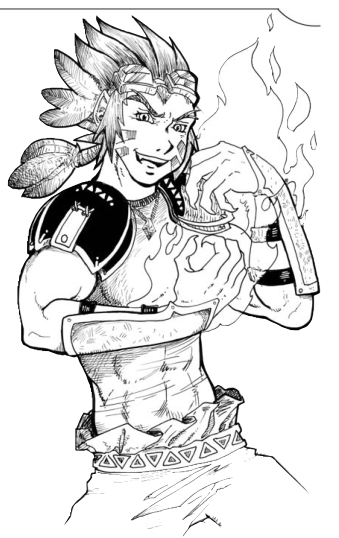
"Everything must burn!"
Here a bunch of other optional rules. Some of them are tied to other rules that appear a bit later, so I'll skip them for now.
Getting a First Strike is already neat in the corebook because it grants you free Fighting Spirit. With an optional rule, this strike can also cause our Super Bar to fill up to 50%. Nice.
Honorable Defeat is probably the only option here that is not about video game emulation, but just roleplaying: With the GM's permission, a Fighter cane forfeit a fight and suffer a honorable defeat. Why would you want to do that? Well, you'll start the next fight with maxxed out Super Energy. Super Moves are fueled by honor.
Normally, Super Moves have a minimum Level of 5 (which correlates with your double hadoken input motions). Some games (like Arcana Heart or recent Mortal Kombat games) make them a lot easier to pull off, allowing for lower levels. They still cost as much as a L5 Super to buy, though.
Super Defense causes you to damage the opponent and gain a temporary defense boost whenever you gain enough energy to pull of a normal Super Move. Sounds like something out of a DBZ or similar game.
Super Protection also sounds very DBZ-ish: if you max out the Super Bar, it turns into an ablative layer of extra health, provided you block the attack instead of doing something fancier.
Super Disarm is what every Samurai Shodown game except the second one (the one what last entry's Weapon Break) does: Every Super that hits causes the opponent to drop his weapon. Naturally, this only makes sense in a weapon-based campaign.
New Super Moves
Here's how things start to get fun.
Climax Mode makes you go Super Saiyan. It costs you 3 Supers worth of energy, but it boosts your damage and allows you to spam Supers for free for a while.
A variant of this is just called Super Mode. Instead of spamming Supers like it's going out of style, you instead gain lots of super armor, reducing incoming damage and protecting you from Hit Stun.
Desparate Attack is seen in some Samurai Shodown games. It's a Super that doesn't cost energy to use, but you can only use it when you're almost KO, and you need to get hit again after each use before it becomes available again.
Energy Move is another free to use Super with a catch. This time around, you can only use them a limited number of times per round. They're only L2 moves (the most spammable kind of Move short of a Basic one), and they always need to be ranged and/or have area effect. That's gotta be from some DBZ or other anime game, but I can't put my finger on it.
Extra Special Moves are EX Moves, as seen in many fighting games like Street Fighter starting with SF3, King of Fighters XIII and Melty Blood. It's a variation on the Liability from the corebook that causes a normal Special Move to cost Super Energy to use. With this rule the Super Energy cost is optional, letting you switch between the normal and beefed up version of the Move whenever you want.
Finishing Strike is BlazBlue's Astral Finish: The Super Move can only be used when you're low on health and still costs Super Energy to use, but hitting the opponent will cause in instant KO. Now that's a scary comeback.
Guard Breaker is another L2 Super, this time with no drawbacks. It has to include the Unblockable Element, which is actually kinda neat is it's pretty much the only way to gain a fast L2 Move with that Element. Turtlers beware.
Killer Combos are straight out of Killer Instinct: Not really a Super Move but similar in power, it gives extra bonuses (more Initiative, Control and damage) for Fighters who string together long combos that go on for more than a turn. These combos must start with dedicated Opener Moves, and they can be better defended against with dedicated Combo Breaker Moves. Proper Supers cannot be used during these Killer Combos unless they have the Super Linker Element.
Mystic Force is an utility Super that temporarily grants the user special rules, the exact effect of which have to be approved by the GM. Examples include being able to use Basic Moves at range (aka ki blast spam), suffering less damage and becoming immune against Hit Stun, or creating a doppelganger for a little rushdown party.
The effect Mystic Force can be merely some kind of super mode for the user (like Battle Fantasia's Heat Up), or something crazy like Arcana Heart's Extend Force that shifts the whole arena into an alternate dimension.
If Finishing Strikes are BlazBlue, then One-Hit Kills are Guilty Gear. Just like in that game, you can us them in the middle of combat no matter how your Life Bar looks like, but they're very tricky to use: They are inaccurate, have short range, and you have to start a timer first to "unlock" them than runs on your Super Energy. Missing with the OHK or letting the timer run out causes you to lose access to your Super Bar for the rest of the round, so I hope you know what you're doing.
On the plus side, you get some nice bonus XP if you land the hit.
Power Move is another L2 Super with a twist. This time, the Move has its own little gauge that grows a little bit slower than the Super Bar. If this gauge is full, it will turn into a timer. You can use the Move while the gauge is still full, but you have to repeat the whole process again if it hits 0. I swear this is another anime tie-in game thing.
A Power Special Move is an otherwise normal Special Move with 3 levels of effect. Using higher levels has you to draw energy from a separate gauge that you have to charge manually. This should sound familiar to you if you like playing as Robo-Ky or Holy Order Sol.
Rage Bar turns the campaign into Samurai Shodown 1. Using a Rage Bar that either works along with the Super Bar or replaces it completely, Fighters will get pissed off when the Rage Bar maxes out, granting them extra damage and accuracy for a short time.
Rage Bar Super Move Variant is an alternative to the above. Now you're so pissed off that Supers become free to use.
Rage Explosion combines the two, except you can decide when to go berserk.
Rage Combo is a very specialized form in the art of getting pissed off. The duration is a lot shorter (you'll most like get one attack out of it), but you get a very juicy Accuracy bonus you can only use to offset penalites from long combos.
Rage Strike lets you cash in your remaining berserk time with a highly inaccurate attack that deals damage depending on how much health you've lost so far. I think that's another Samurai Shodown thing.
Revenge Move is the Ultra Move system from Street Fighter 4. It's another Super with a spearate gauge, the twist here being that you can use the Super when the gauge is halfway full, but each point above that will increase the damage.
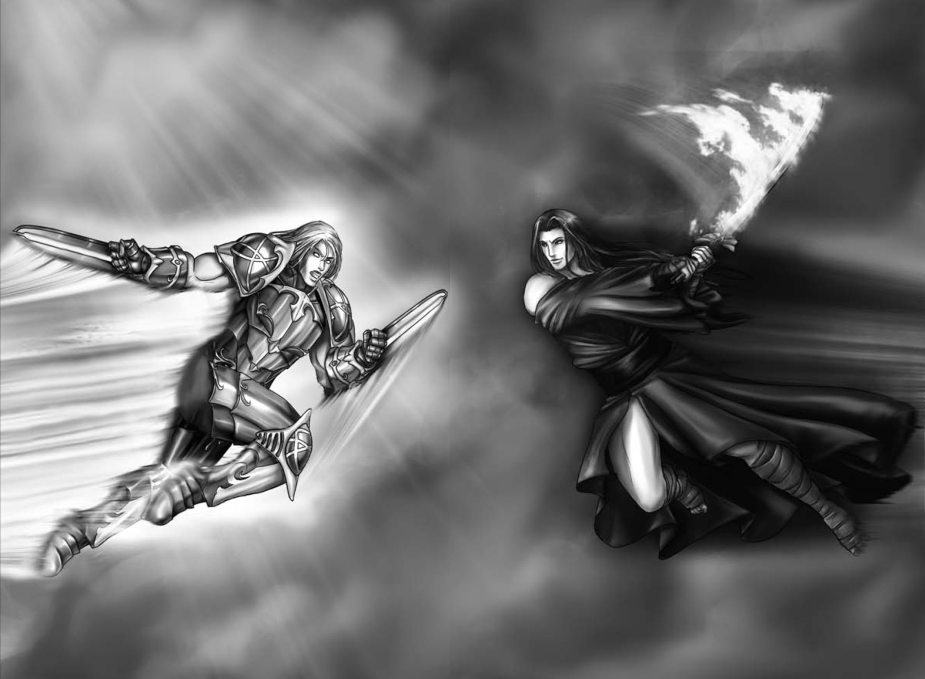
Soul Calibur Z
(You might notice a little line in the middle. This was a 2 page spread I pasted back together)
Finishers
Unlike the above One-Hit Kill which doesn't actually have to kill the opponent, this obvious reference to Mortal Kombat is not quite as nice, at least in its classic iteration. This is a stark contrast from the normal approach of defeat in Fight! which states that nobody ever dies unless the plot calls for it. Probably not very useful for long campaigns, but certainly good for a short bit of "Tomb of Horrors: PvP Tournament Edition".
The way Finishers is work is that you built a Super Move that can only be used if you've already won the fight. It adds an extra turn to the fight in which the winner tries to win Initiative and roll enough Control to pull the Finisher off. Success grants bonus XP and generally has unfortunate consequences for the loser.
The classic Finisher straight up offs the loser. Naturally this can cause problems, like PCs falling prey to what is essentially a save-or-die effect, or the PCs killing off all the NPCs (aka what would happen if you ran an accurate Mortal Kombat campaign). The GM can fudge things a little, like say only grievously injuring people. I love the suggestion that it's generally no problem at all for "killed" Fighters to come back in later campaigns. Just like in the games :3
For more MK emulation, the GM might designate the arena to have its own Arena Finisher, which is even more gruesome and earns even more XP.
Brutal Finishers aka Brutalities are very hard to pull off Finishers whose XP reward is very swingy depending on how high your Initiative is. It usually involves you pummelling your foe till they explode in a fountain of blood and bones (which may or may not include a suspiciously high amount of ribcages and skulls). Man, I'd like to see Kenshiro in the next MK game.
Ally is a much nicer alternative that instead has the winner try to become BFF with the loser, provided the loser is into that sort of thing. Mortal Kombat uses this "Friendship!" move as a way to humiliate the loser and poke fun at the franchise's ultra violence, but I can totally see this work in a campaign based around shounen or magical girl shows. Defeat is friendship.
(Thankfully this doesn't involve brainwashing. Ya gotta earn your friendship by roleplaying through the fight)
If you feel like being a dick, you can try Humiliation instead. Instead of killing the opponent, you pull off an atomic wedgie, a Babality or something equally silly. This not only earns you XP, but causes the opponent to lose XP, which might even cause him to gain what are essentially negative levels.
Mercy is an option you can use instead of a normal Finisher, best used in a tournament environment or in other "honorable" environments. Instead of finishing the loser, you instead duke it out in a bonus round that will decide the winner. The loser only has half his Life Bar and Fighting Spirit, but he can still pull off a victory.
Savage Finishers are more or less Animalities. They reward a lot of XP, but are difficult to pull off as you have to use Mercy before. They typically involve you going berserk, turning into an animal or just summoning an animal to utterly maul the loser.
Special Killer Combo Finishers
These are from Killer Instinct and are naturally tied to Killer Combos.
A Final Killer Combo is a finisher in every sense of the word, being used to end a Killer Combo used to win the last round.
Super Killer Combos have the attacker land an automatic flurry of blows that often launch the opponent out of the arena. They aren't lethal, but will generally have a lasting impact.
Special Killer Combos are a less flashy version that you can use after any round you've won, even if the fight is still undecided.
Custom Combos
This is straight out of Street Fighter Alpha: By using up all your Super Energy, you can enter a special mode that makes it easier than ever to string together long combos. If you want, you can keep SFA's quirk of having the character continuously move forward during the Custom Combo, which gives the defender a bonus if he tries to jump over you at the start of the combo.
Next Time: Okay, now I'm gonna take you for a ride.
Combat (Samurais & Shodowns 3rd Impact Edition)
Original SA post Fight! - Round 2
Chapter 5: Combat (Samurais & Shodowns 3rd Impact Edition)
Fight! is all about those kind of campaigns where you have to punch evil jerks who somehow include "organize an international mixed martial arts tournament" in their grand master plan to destroy/conquer the world (or something less ridiculous, if you're into that sort of thing), so it's no wonder the game is pretty big on beating people up. So enjoy some more optional rules about doing just that!
The Cowardice Gauge is a feature heavily inspired by Guilty Gear: You try to keep your distance from the enemy and not get hit, and the gauge will rise. If it's around halfway full, you'll suffer extra damage. If you're chicken enough to let it max out, this bonus damage will stay for the rest of the round.
Spark causes two Fighters to lose their turn if they're too close to each other and tie on both Initiative and Control, signified by some flashy animation. This is probably an emulation of the "clash" mechanic seen in games like Arcana Heart, whereby hitting each other at the right timing causes the two attacks to cancel each other out.
Going Full Offense in the corebook improves your chance at landing a hit at the cost of becoming more vulnerable in turn. A bit reckless, but you still know what you're doing. Berserk Attacks happen when you're just trying to button-mash your way to victory. Naturally, as a more extreme form of Full Offense, your own defense drops to basically nothing, but you get to roll a friggin' d12 for your attack roll (you normally roll a d6).
Unfortunately, there are a few hefty downsides to this: The uncontrolled and downright random nature of your attacks prohibits you from boosting your Initiative and Control with Fighting Spirit, your Control is set to 1d4 (though there's some exploding die shenanigans going on that might just work out in your favor), and the opponent gets a defense bonus if he decides to turtle this nonsense out.
And since button-mashing is considered to be a rather n00bish tactic, you'll earn less XP from the fight. If you overuse this - especially against a more honorable foe - you actually lose XP.
Rounds normally go up to a time conut of 99, but you can remove this limit if you want. You can also reduce the count to better emulate certain games (Virtua Fighter only has 30-second rounds for example). To ensure that KOs still happen in that short amount of time, everyone gains a damage bonus depending to go along with the lower count.
For some extra shenanigans in more beat-'em-up-style scenarios, one can also introduce facing rules. Getting hit from behind causes extra damage and causes you to automatically turn to face the opponent.
Combos
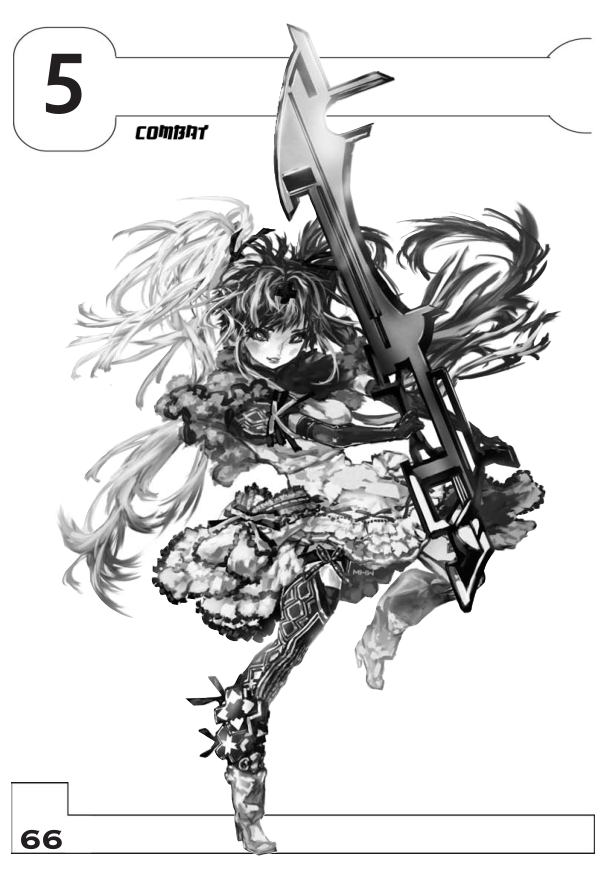
This artist has some weird anatomy going on, but I like the style.
Combos are important to really dish out the hurt and straightforward to use, and they help you get around certain Move limitations, like say using a Shoryuken that doesn't really cover a lot of horizontal distance on a faraway opponent by first doing a jumping kick or so.
The one tricky part for newcomers is probably how combos are handled as a single attack where either everything hits or nothing, with an accuracy penalty depending on how many Moves you put into it. This is mostly to speed things up and balance the additional damage you can deal with them.
(Partially succesful Combos are best described as trying and failing to win Initative in the next turn to essentially "continue" your Combo, even if it's a whole separate attack in game terms.)
Burst Combos are Roman Cancels, as seen in Guilty Gear and many other games since. By paying a bit of Super Energy, you can instantly skip the recovery animation of whatever attack you've been doing, allowing you to string together combos that would otherwise be impossible.
In Fight!, this lets you follow up a succesful Combo with an extra turn to start another Combo, provided you have enough Super Energy and suceed at a Tactics check (otherwise you screw up your timing). This is pretty nice to get full mileage out of buffs you have, and it helps to punish turtlers as you can also use this if the defender succeeded at blocking your previous Combo.
Chain Combos is something you seen just about every recent 2D fighting game: each character has a more or less unique pattern of base attacks that flow particularly well into each other, usually starting with Light and ending with Heavy attacks. If you want to emulate this in Fight!, you can grant a Control discount to Combos that only include Basic Moves, which is especially helpful for Fighters that keep ending up with little Control to play with.
Another 2D figher staple is Move Buffering: By buffering a Move's input during the frames of a base attack, you can optimize your combo potential. Fight handles this with a special 2-hit Combo (a Basic Move followed by a Special Moves) that gains extra accuracy. Another nice option against defensive opponents.
The corebook already let you make characters like Kyo Kusanagi or K' from KoF who have a certain subset of Moves that can only be used following a specific other Move. An alternative to this are Circle Combos, meant to envoke characters like Angel (also from KoF) and to a lesser degree the EX Version of Guilty Gear's Slayer. The Fighter can have a subset of Moves that combo into each other in a circular pattern. You start the pattern with a designated Combo Starter and can have a different subset of Moves to act as Combo Enders, which you can only use at the end of a Circle Combo. This is also totally how you can turn the Assassin from the Diablo 2 expansion into a fighting game character.
Like the Multi-Part Liability from the corebook, this lets you have stronger Moves (thanks to the Liability everone has) at the cost of less flexibility. As long Combos can have you end up at the start of the pattern, this is also the only way to include the same Special Move more than once in a single Combo.
The other way to include the same Special Move multiple time is with the Duplicated Special Move rule, which just gets rid of that restriction entirely. Since that doesn't have any caveats attached to it I'd be wary of using that. Building a single cheesy Spcial Move to fill up all of your Combos does sound way too tempting.
Combo Knock Back describes an effect often seen in 3D fighters, especially Virtua Fighter: while air juggling your opponent to hell and back, you'll often end up covering quite a lot of distance due to all the knockback going on. With this rule, you can have each individual hit in a Combo cause knockback, instead of just the Combo as a whole. This shortens Combos quite a bit as you have to pay extra Control to keep up with the juggled foe, but you can more easily nudge him towards an Environmental Hazard, for say a ring-out.
Combo Stun is a nasty little rule that automatically stuns you if you screw up your Combo by too big of a margin. Not sure where that comes from, but sounds nasty.
Dash Combo is a variant of the Burst Combo: If you do a Combo out of a Dash, you can pay Super Energy to make another Control roll and add that to your current total. That just has to be some anime thing.
You dreams of the ultimate Combo are being limited by the nefarious Combo Skill? Fear not, for the Easy Combos rule removes that Skill from the game, making Control the only cruel mistress you have to deal with and simplifying things a little.
If that is not enough Combo insanity for you, how about Really Easy Combos? This one keeps the Combo Skill, but instead of restricting the number of Moves you can have in a Combo, the Skill is instead added to your Control for the sole purpose of figuring out how much pain you can put into a Combo.
Both rules can also be used to kinda sorta do these "auto combos" seen in Under-Night, KoFXIV and the Persona fighting games, where the characters can turn timed button presses into automatic, pre-set combos.
If you prefer something more oldschool, like say earlier Samura Shodown games where Combos weren't really a thing, but even basic attacks could deal 1/4 or more of your health bar, you can try out Infrequent Combos. This makes the Combo Skill a lot more expensive, but all of your Moves will deal double damage to compensate.
Simplified Attack Strings can be used to emulate the feel of 3D fighting games without using the Attack String rules that an extra layer of Combo rules. The GM can simply rule that any Combo including a certain number of Basic Moves causes an automatic knockdown.
Damage
This includes to easy options to handle damage: If you want a more "accurate" fighting game experience, you can replace all tie damage dice with fixed damage.
If you want to make really damaging Moves a bit less predictable (since any die increase after 1d12 just becomes a fixed damage bonus), you are offered a number of ways to turn that 1d12+X roll into two rolls with differently-sized die.
Stunning
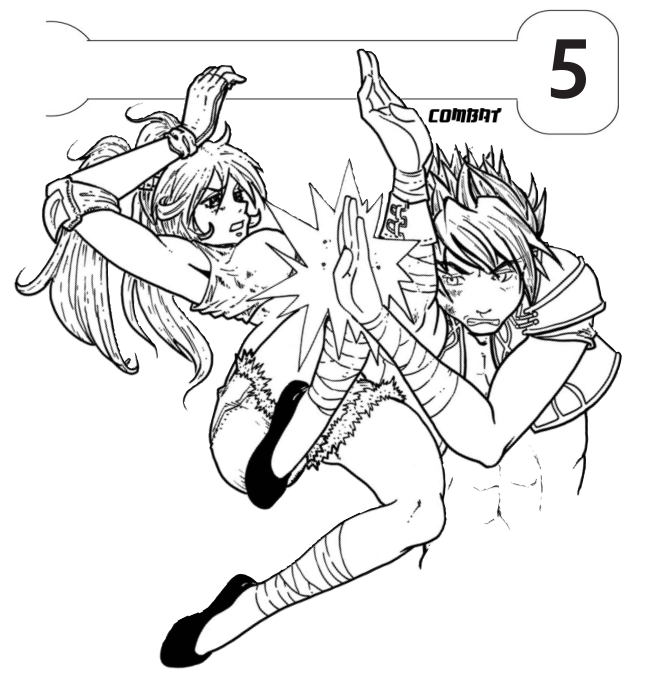
"Are you hitting on me?"
One of the fun things of curbstomping an enemy in a fighting game is seeing him get stunned. The rules for stunning are pretty straightforward, but how about a bit more versimilitude?
Accumulated Stun Damage is more accurate emulating of what most fighting games do, in that you have a (usually hidden) stun gauge that gets filled whenever you're hit and starts dropping if you aren't. This works mostly like the base rules, except the stun damage carries over from turn to turn.
Staggering is often seen in 3D fighters, where the classic full-blown Stun is rather uncommon (though you can use both rules at the same time). Getting hit by an attack will not only cause Hit Stun (aka reduce your Control), but also put a hard cap on your Initiative die's size on the next turn. The harder you've been hit, the lower the die. Big burly fighters having to deal with pesky ninja dudes can finally rejoice.
For more randomness, you can tie your chance of becoming stunned to a Stamina Check you do when taking damage. Glass cannons beware.
An interesting little system (aka "I have no idea from which game this is") is the Super Energy Reserve, which ties getting stunned to your Super Energy: Getting hit reduces your Super Energy instead of raising it. If you're out of Super Energy, you're Stunned, and then your Super Energy will slowly grow till the bar is half full.
Super Moves don't auto-stun you as they will always leave a tiny bit of Super Energy, but you're a short Combo away from being stunned, so you'll probably be more careful using those Supers.
Defense Options
The holy triforce of defensive options in Fight! is the Defense Skill, which is for simple and effective blocks, the Evasion Skill which lets you avoid the attack and get into a more favorable position, and the Tactics Skill which doesn't get as many situational bonuses as the other two but is your main source for all sorts of counterattacks, which make you look pretty badass when you're countering multiple enemies in a single turn.
For Defense, you can add a typical 2D fighter Block Bar to your game. One version acts like in most games (aka blocking too much causes a Guard Crush), while the other one works like in Guilty Gear (blocking to much makes you suffer extra damage on a hit, while getting your teeth kicked in long enough makes you suffer less damage).
Where Block Bars encourage too much blocking, Imbalance encourages it by allowing you to push the opponent away and debuffing his Initiative. I swear I've seen one or two games with that, but I can't remember exactly which one.
A variant of this works best for weapon-based campaigns: Push and Pull. Similar to the combat system in Way of the Samurai, you can draw the failed attacker closer to you or push him away.
For Evasion, you can do Crouching Movement as seen in many 3D fighting games. If you slowly approach the opponent without attacking, you can get yourself a nice evasion bonus thanks to your small hitbox. The Low Crouch on the other hand gives you another option to do a stationary evasion.
People that have played 2D and 3D fighting games will probably notice that the latter offer far more limited jumps. With Limited Jump Rules, you can capture this effect by reducing the distance you can cover with a succesful dodge.
Tactics also gets a few new options: Anger Response lets you pay Super Energy to counter with a Basic Move that knocks the opponent down and debuff his Initiative, as seen in a lot of games.
Burst Response is the defensive counterpart of the Burst Assault, and naturally also based on Guilty Gear. If your Burst Gauge is full, you can cause the attacker to automatically miss, knocking him back and away in the process. Essentially a "Get out of jail for free" card.
Parrying is most commonly associated with Street Fighter 3, where you can avoid chip damage and block stun if you hit forward at the last frame. In Fight!, this nets you a very juicy Initiative buff, allowing you to quickly go on the offensive on your next turn. This also grants you some extra Super Energy. Make that Life Bar instead of Energy Bar, and you kinda have Garou's Just Defend.
Reaction is a more Last-Blade-ish option that grants every Fighter the capability to counter enemy attacks. If you've blocked it (not all Tactic Responses actually use the Tactics skill), you can punish it with a Basic Move.
Other defensive options include the Air Escape (aka aerial recovery, essentially a variant of a breakfall specifically meant to counter juggles), Automatic Tech Rolls (which lets everyone freely reposition themselves when knocked down) and Back Dash Invincibility (grants a nice defensive bonus if you back off from the attacker via Back Dash).
Weapons
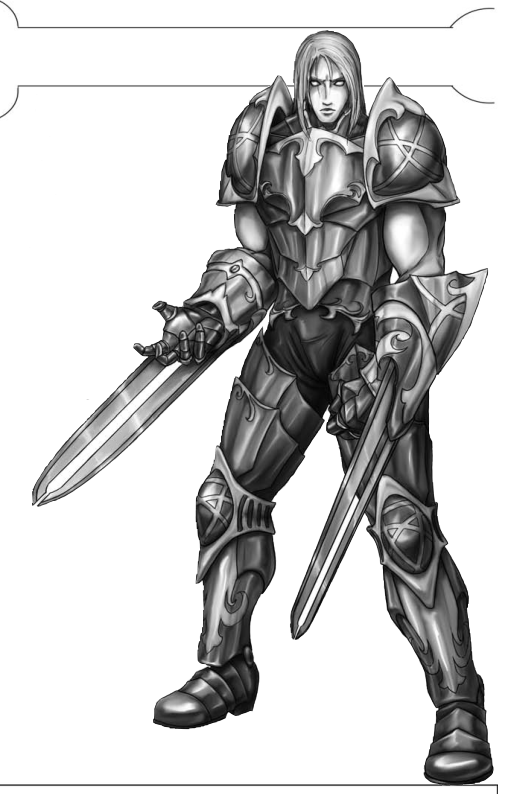
I kinda dig Siegfried's resedign.
As mentioned previously, the rules normally don't care if a Fighter uses weapons or his heavily armored. This stuff is just window dressing for his build and move set.
But we've already seen a couple optional rules for campaigns where everyone uses weapons, like say Soul Calibur or Samurai Shodown. It's only natural to have a section dedicated to weapons.
Armor is a rule based on later Soul Caliburs and I think some older fighting games. Everyone is decked out in armor that reduces incoming damage, and getting stunned for the first time breaks the armor instead of stunning you. Armor Locations grants you a second layer of armor that reduces damage while it's up.
Optional Weapons are inspired by some Mortal Kombat games. Everyone has a weapon, but he functions well enough without it. Drawing the weapon boosts your Basic Moves, but getting knocked down or stunned has you drop the weapon.
Weapon Clash is straight from Samurai Shodown and works similar to the above Clash. Instead of losing a turn, the two Fighters have a contested roll, the loser of which will be disarmed.
The Weapon Damage gives everyone a Life Bar for their weapon. Blocking Special and Super Moves causes the weapon to suffer damage, and you can customize those Moves to deal different damage to the weapon or opponent. A KOed weapon causes a disarm. Better use a shield.
With the Weapon Power rule, you can purposely "hurt" your weapon to pull off a Super.
Team Combat
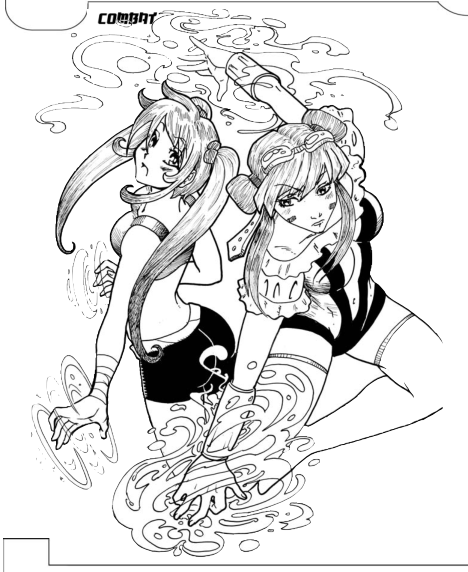
These two will end you with the power of love and friendship.
We all know that team-based fighting games can get pretty crazy with Supers and other options, so it makes sense to include more rules for your Skullgirls and Marvel vs games. They also offer more options to include "inactive" team members more often in the fight, which is always nice.
First up, options for Tag Teams:
Instead of tagging in your tag buddy, he can instead use an Assist Attack to enter the fray for one attack, with the risk of getting punched by the opponent. A Tag Attack works similar, except it happens during an actual tag out.
Sustained Hold Assist has the tag buddy try to help if the active Fighter is currently stunned or in a Sustained Hold. Very wrestling-y, just like the Tag Throw Element that allows you to tag out by throwing the opponent to your tag buddy. If said buddy has a Move with the Tag Throw Combo Element, you're basically doing a tag team wrestling special.
Many tag-based fighting games have the inactive member recover a bit of health, so have some Teammate Recovery rules.
Tag Team Supers are pricy, but very useful. They're best used when the whole team shares a single Super Bar which can also store quite a bit of energy, though that's pretty much the default in those kind of fighting games.
You know how in Skullgirls, you can forcibly tag out the opponent to say avoid the inactive guy from recovering too much health? Drive Back let's you do just that.
Super Move Sequence lets the tag team rapidly tag in and out to use their respective Super Moves in the same Combo. Ouch.
If that is not enough hurt, try the Team Combo: If you pay extra Super Energy and hit with your Super, you can have your buddy tag an and pull of a Super of his own at the same time. If there's a 3rd member in the team, he can join in, too.
If this is still not enough hurt, the Super Team Combo lets you pay a lot of Super Energy to temporarily turn this tag match into a 2-on-1 beatdown.
Tag Counter is an Element that lets you tag in after your buddy has blocked an attack to do a counterattack for him.
If you want jolly co-operation in a match without tagging options, you can build yourself a Team Up Move that has your buddy jump into the ring as part of the Move's description. The result is an expensive Super that has an a lot of Elements for its low Control cost. Not sure where that's from.
A variant of this is the Super Energy Team Up Element, which causes a net gain of Super Energy if you pour enough slots into it. They involve the other member encouraging and/or assisting you. Never underestimate the power of friendship.
For some King of Fighters action, you can simulate the subsystem found in some games where the next fighter entering the ring will gain a bonus or penalty to the Super Bar depending on how good or bad his relation with his defeated buddy was.
Helper Characters
One of the crazier things KoF has done were Strikers during the NESTS saga. They were an extra team member that acted as a sort of equippable Move.
In Fight!, these are called Helper Characters, which basically work like low-Control Super Moves that have a limited number of uses. If the Helper attack is your only attack for the turn, you gain a buff on your next turn since you let the other guy do all the work and get into a better position.
Roleplaying purposes for Helper Characters are great: You can buy a Helper Move for every other PC or NPC to have them jump in and help you out of you need some quick help. This even works if the character is having his own fight at the moment. They multi-task like crazy.
Companions
Companions are small pets, robots and similar critters that fight alongside you. You can do it like in Samurai Shodown where the pet animals used by some characters are just flavor for some Moves, or you can have your Fighter be more like Carl Clover, Lieselotte Achenbach or Ms. Fortune who have a bit more mechanical crunch to their Companion.
A Companion is actively summoned by the Fighter and sticks close to you. He has his own shorter Life Bar and gets hit whenever you do. KOing the Companion causes it to not be available to summon until it recovers.
While the Companion is out, your Basic Moves gain more reach, every attack deals a bit more damage, and you might persuade the GM to let you use a Technique or two (like say getting an air dash or double jump if your Companion has wings). Moves performed by the Companion are handled with a Liability.
With the Companion out, you can try a special Super called a Tandem Attack. It takes a turn to set up (giving the opponent a chance to KO the Companion) and effectively lets you do two attacks at the same time.
Optional Rules for the End of the Turn or the End of the Round
These rules add some twists to the end of a turn or a round. With Double Life Bars for example, you can simulate games like Last Blade where the winner of a round doesn't recover his health bar because everyone actually has two of those. This is basically a more realistic approach to the round-based combat structure.
Insert Coin Continue is just hilarious. The player wasn't satisfied with the outcome of the fight? Well, have him pay XP to re-do the fight!
Judgment is similar to the system found in KoFXI: The winner of a round without a KO is not decided by who has a higher percentage of his health remaining, but by other factors like who had the most successful attacks.
Life Bar Recovery makes fights go on longer and discourages turtling, since everyone heals a bit of his Life Bar each turn.
Environmental Hazards
As mentioned, too many hazards can make things confusing, but careful usage can really spice things up and add more depth to the arena.
Wall Stun causes an auto-stun when you're knocked into a wall, because you've ben electrified or hit by a falling object.
With Wall Counters you can try to use the wall to jump out of the corner and potentially start a counterattack.
Destructible Walls is very Virtua Fighter: Getting knocked into a wall can cause extra damage and the destruction of the wall.
If you love Beat-'em-Ups, Smash Bros. and to a lesser extent Samurai Shodown, you can sprinkle some Environmental Power-Ups throughout the arena. Health recovery items? Check. Temporary weapons? Check. Guns? Double check.
Freefall Fighting is used in conjunction with elevation changes. It causes both Fighters to duke it out during freefall, with the loser taking damage and getting knocked down.
Random Hazard is like a Dnager Zone from the corebook in that it causes damage if you're to close. Unlike the Danger Zone, the Random Hazard is well, random and not always active. A lot of Smash Bros. maps have this.
Ropes is primarily for wrestling games and lets you attack the opponent with extra momentum.
Weapons of Opportunity is for your Injustice and recent Mortal Kombat lovers out there, letting you use environmental features for improvised attacks.
Also from the same games are Zone Barriers, which let you take the fight into a different arena by launching the opponent through a wall, door, down some stairs...
Aerial Combat
This is straight up DBZ, allowing every Fighter to take the action to the sky. Now everyone's at a specific altitude, which turns the map from a 1-dimensional lane into a proper grid.
If DBZ is not your thing, you can easily use these rules to play Fight! on a normal grid.
Next Time: Systems and Settings. Time to d-d-d-duel. With guitar ninjas. I'm so not kidding.
Systems and Settings (Shadow of the Game Attorney)
Original SA post Fight! - Round 2
Chapter 6: Systems and Settings (Shadow of the Game Attorney)
This is a rather short section on campaign building and GM tools. No pictures here, but I've got a few from somewhere else. You'll thank me later.
Building Thugs
Thugs are the mooks of the game, very similar to your typical beat-'em-up punks. They appear in large groups, don't have a lot of attack variety (to the point that they only have one attack eachin Fight!), and fall over easily. Instead of a small Life Bar on their own, they just get a "Life Save" akin to a tabletop wargame.
The Thugs' overall strength and the PCs skill distribution (with or without enforced hard caps by the GM) can greatly change how fights with Thugs feel. You could have swarms of Thugs that fall over like Dynasty Warriors grunts, or vicious elite mooks that can actually put up a fight. Or both at the same time.
In the corebook, Thugs were tiered into levels, from "Normal" aka level 0 for civilians up to level 5 for dangerous Thugs who hit hard and have enough Quality slots to fill up with goodies, like the ability to inflict Hit Stun (which Thugs don't do by default) or being close enough to a proper Fighter that the PCs don't gain extra actions against them.
If those 6 levels and customization options aren't enough, Round 2 introduces a point-buy system. Just write down the desired stats and effects and compare the total with the base templates to see how weak or tough the creation is.
These point-buy rules also come in handy for a certain campaign options: The first chapter of this supplement introduced the "Hidden Abilities" Weakness that locks your move set behind having to henshin, put on some power armor or whatnot. If you think that still being able to kick ass with Basic Moves and such is still too much, how about having the PCs built their unpowered PCs as Thugs, and having them buy the new Combat Training to suck less as Thugs?
Since an unlucky save can cause Thugs to go down in one hit, fighting in this state is pretty darn scary. Still, very fitting if your campaign looks less like Street Fighter and more like Gundam or Sailor Moon. You might even pull of Metal Slug if the PCs are stuck being Thugs.
Social Combat
This is the big one. Social Combat has an odd fasciniation for certain people, as it promises to expand simple skill rolls or roleplaying with the excitement and tactical finess of the system's combat rules.
The end result of this noble goal can end up a bit weird, though: You either have something like Exalted were Social Combat is just plain mind control, or you end up with a "Lite" version of the normal combat system were everyone can do the same action.
Fight! doesn't screw around with its attempt at Social Combat and just uses everything from normal combat: the 1-dimensional map, Combos, Special Moves, even Super Moves. There's even an extra layer since everyone has a pool of points to activate fitting Qualities on themselves to gain bonuses or Weaknesses on "opponents" to give them penalties.
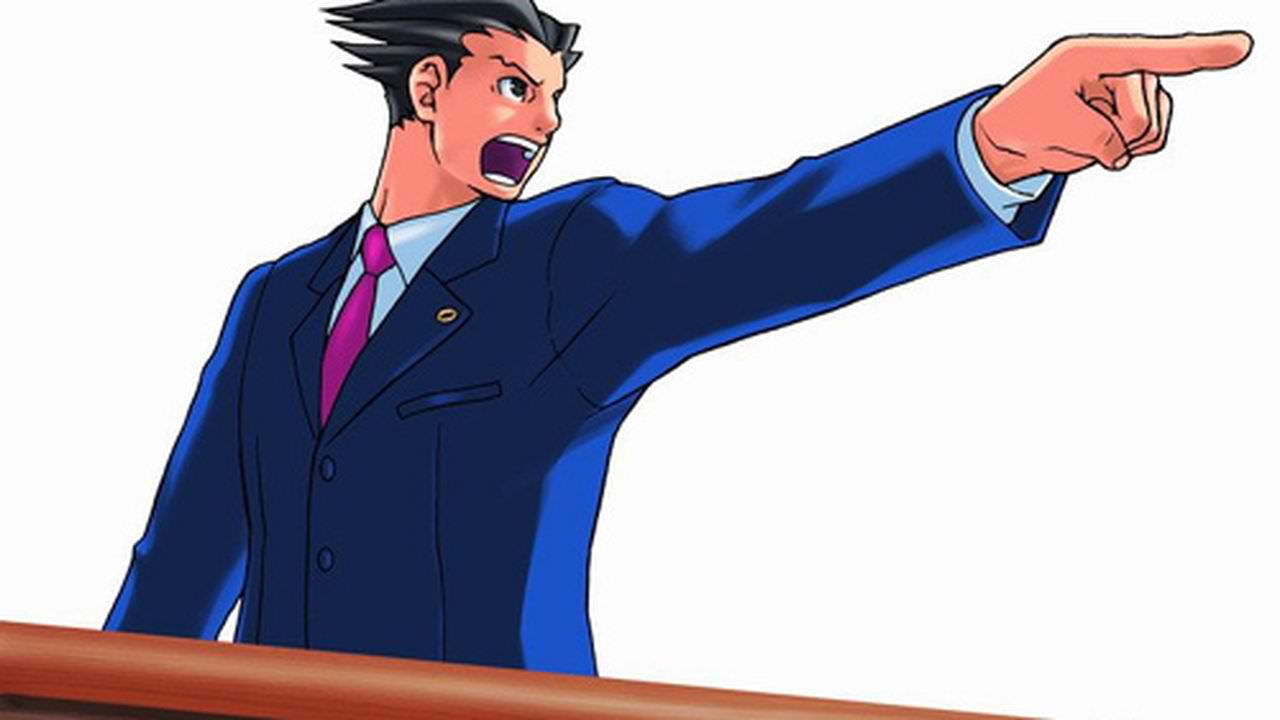
He will verbally juggle you out of prison.
Once everyone's on board with building "OBJECTION!!" as a Super Move, it's time to change the character creation and advancement rules. Characters now have around 50% more points to play around with, with the catch being that they have to divide these bettn normal and social stuff.
I'd probably be careful letting PCs overspecializes, lest someone derails the campaign with a Social Combat monster.
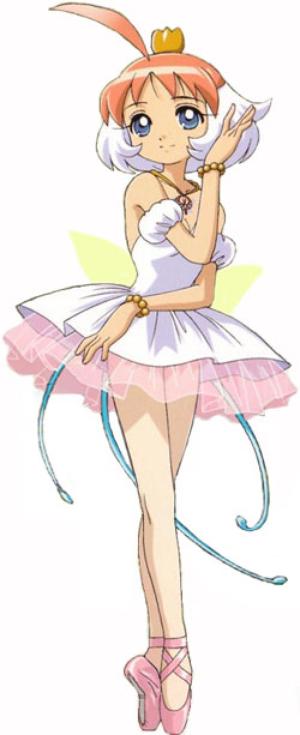
God tier, plz nerf.
Alternate Campaign Styles
This section gives a few guidelines to adapt Fight! to something less orthodox by fighting game standards:
If Capcom's excellent duology of Mystara beat-'em-up is any indication, then something like Fight! and Traditional Fantasy Gaming can work quite well. This type of campaign should make plenty use of Thugs and Dramatic Combat, where Combos aren't a thing, Moves are used more like Encounter Powers and you can use all sorts of non-combat skills to affect the outcome of the fight. PCs should also be separated into "Warriors" who are created normally and "Non-Warriors" who focus more on skills than raw combat ability.
This section also introduces a nice modifier to the Buff element that lets you Buff others to simulate support spells.
Mecha Gaming is more straightforward. Since pilots rarely fight outside of their mecha, you can usually get away with building them as a single character.
Supers Gaming probably has everyone invest in the Powers Quality, and the Dramatic Combat has probably the most cinematic feel for this type of campaign.
That's all the book hightlights, but you can easily come up with other stuff. Why, I think most of us should be familiar with a certain long-running franchise whose characters and plotlines are about as ludicrous as your typical fighting game, except conflicts are settled in a less physical way...
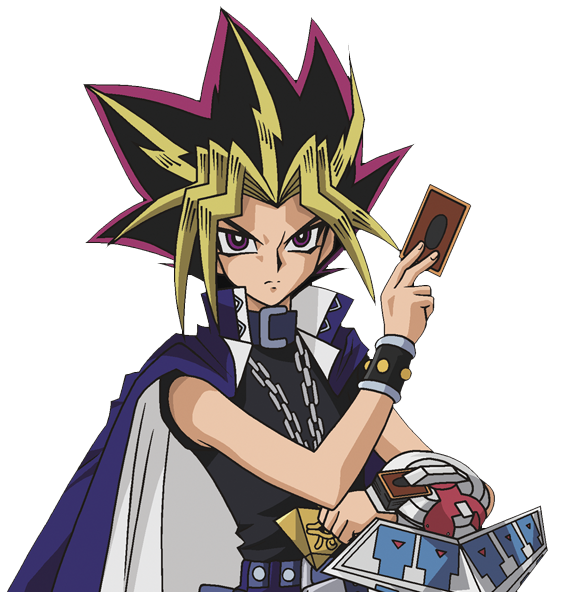
Duel Fighters - where every character is Testament.
FAQ
A collectin of answers, clarifications and sometimes corrections, most if not all appear to come from the game's Google group page. Very oldschool.
And then the book ends with an Appendix of all the various campaign options, and where to find them if they're from the corebook.
Bonus: Example Character (Warning: A new wall of text appears!)
Now let me whip out a character I didn't know exist until like two pages ago, using my fighting game knowledge and investigative journalism powers. I picked Power Level 3 as starting point because you can get your first Super at that point, and your defenses start to look a lot more well-rounded.
quote:
Pullum Purna
A wealthy princess from Saudi-Arabia (or just somewhere in the Middle-East, depending on the Bio) who alongside her bodyguard Darun Mister ran into a couple non-canon Street Fighter shenanigans in her quest to find her father (who may or may not have ties to Shadaloo).
Pullum is a dance battler with a heavy focus on swift kicks, including drill kicks similar to Cammy and Dhalsim, a sommersault kick that reminds me a lot of Virtua Fighter, and a downward kick like Kim from KoF would use. Sounds pretty fun.
At PL3, she has 50 points in her Life Bar (which we can't change in any way) and 30 points of Fighting Spirit (which we can raise).
The most important step for a character is figuring out the Basic Qualities of Strength, Speed and Stamina. We can pick a balanced array (1/1/0) or a specialized one (2/0/-1).
Since she's one of these fastest characters in the game, and these dance-types rarely top the health rankings, I go for Strength 0, Speed 2 and Stamina -1. To double down on the Speed, I use that 2 solely to boost Iniative, giving her a base die of 1d10 instead of 1d6. Anyone trying to go before her has to pay Fighting Spirit to keep up, which in turn helps her conserve Fighting Spirit for stuff like not trying to get hit.
Every Power Level beyond the first grants Combat Bonuses, one of the few static bonuses in the game. I put a +1 in both Control and Defense. The former makes it a bit easier to consistently pull off Combos and Special Moves, and the latter is added to the Defense Total any attacker has to beat, no matter how she's trying ot defend.
Other possible Combat Bonuses were Damage and Accuracy. The former is only added once per attack, not for each hit in a combo.
Next up are Combat Skills. There are 11 points to spend, with the three defensive skills (Defense, Evasion and Tactics) currently having a hard cap of 3. I go for Defense 2 and the other two at 3, leaving 3 points for Combo and 1 in Ki (which we need for the Super later).
The 3 points in Combo allow for 3-hit Combos. We can later increase these Skills later.
Non-Combat Skills are your "normal" skills. We have 35 points to spend, with a current maximum of 9 in any given one.
Agility and Thug Thrashing are primarily used when dealing with Thugs. The former makes it harder to for them to hit with ranged attacks like guns, while the latter grants extra attacks against Thugs. 5 points in each sounds good in case some punks or Shadaloo soldiers show up.
SInce Pullum is rich belly dancer, I can probably not go wrong with spreading the remaining points among Acrobatics, Athletics (for general gymnastics stuff), High Society (etiquette), Performance (belly dancing), Presence (basically posing to get everyone's attention), Smooth Talking (diplomacy). So far, so good.
Qualities, Weaknesses and Quirks are for you merits and flaws. Pullum currently has 5 Qualities to pick from, and can potentially gain more through Weaknesses. Leftover Qualities can be turned into Fighting Spirit or Combat Skill points.
A Quality she'll most definitely need is Technique, since she's one of the few characters in Street Fighter Ex with a double jump (which got turned into a Move in EX3, but man does that sound awkward). This lets her boost her Evasion if need be.
Fight! has a bunch of Qualities that give little bonuses to various forms of interaction depending on what fighting game tropes a characters falls into. Pullum definitely qualifies for Attractive, Charming and Sexy. Only characters like Mai Shiranui would serve as better faces of the party.
Being wealthy also easily qualifies her for the Wealth Quality. Having the party travel across the globe should be no issue.
Since one of her goals is finding out what happened to her father, this could qualify for a Weakness, probably a Vow of sorts that can tempt her into making poor decisions.
This Weakness grants us an extra Quality, which we'll keep in reserve for now.
Quirks are harmless character flaws or similar things that make the character stand out. Around 1-2 per character sound okay. I give her Distinctive Appearance because she's a belly dancer and Clueless because she messes around with Shadaloo despite not knowing a lot about them. Impulsive could also work.
Now onto the fun part: Special Moves! We have 30 points to get those. And since they are in just about every fighting game known to man, I also give her a free Sweep and Basic Throw to go with it.
The Sweep is a Command Move that deals damage comparable to a Basic Move, but also hits low (more accurate against blocks, less so against evasions) and knocks down. The Basic Throw is a L2 Special Move with the Throw Element, leaving 1 free slot for customization. Her most basic throw is Ordence Foot, where she grabs the opponent and gives him a hard kick. I'll go with Hurl for more knockback and to occasionally kick the opponent against a wall or something.
She also has a somewhat more elaborate (L3) throw called Neck Factor which I'll add because Frankensteiners are always fun. Smashing headfirst into the ground gotta hurt, so more damage it is. Position Shift also seems fitting, which adds some options if there are more opponents or Environmental Hazards around.
For a fast Command Move (aka L2), she has the Alacer Wrist, which has her step forward and do a punch. I'll add a bit of Fast Recovery so she can use this to prepare for the next turn.
Her first proper Special Move is Drill Purrus, a forward spinning drill kick like Cammy. It's a L3 because it is pulled of with the standard Hadoken motion, and it gets the Elements Mobile (to move farther before attacking) and Knockback Advance (which causes her to stay close to the opponent after the knockback). This leaves 2 more Slots, which go into Damage.
She can also use the Move in the air, which is build as its own Move. It has L4 (gotta press some "up" direction to jump first), and the exra slot goes into Aerial. This puts her in risk of eating a Shoryuken, but any other type of interrupt or counter will be easier to avoid since she's airborne.
Purim Kick is basically a Shoryuken (aka a L4 Move), except done as a backward somersault kick. It's an anti-air Move that knocks down on a hit, but allows no prior movement because she's just jumping in place. Since the kick comes out quite fast I also go for the Subtle Element, which makes the Move harder to counter. The rest goes yet again into damage.
Ten'el Kick (a L3) is a downward kick. She can jump over projectiles with this, so it gets an Evades Ranged, with Move Before Attack because we're in the supplement now. I also throw in an Hard to Evade because the kick's arc makes it hard to jump over.
Finally her first Super. I'm cheating a bit here since she has a bunch of more normal Supers that would probably come first, but who cares? I want to defeat enemies with dance.
Gradeus Pearl has Pullum whip out her tambourine and shoot a musical note at her opponent. Getting hit starts an animation where she forces the opponent to have a dance off, which she will of course win.
This Super would normally be a L7, only usable as a tier 3 super in a game where every Super has 3 tiers like in Street Fighter Alpha. Screw that, I'm making it a normal Super, aka L5.
As a Super, I have a whooping 10 Elements to play around with, though at least half must go into specific Elements: the pricey Increased Accuracy (why not? We can afford it), Increased Damage (yes), and Breakthrough and Invincibility. Breakthrough allows for partial arts (which does not apply here since either the projetile hits, or nothing happens), and Invinciblity lets her steal Initiative if the rolled totals are close enough. Well, she's already quite fast, and the thing about these projectile supers is that it really sucks if the opponent sees them coming to soon, so I think this doesn't quite apply either. She can still win initiative in case of a tie, since all Supers can do that.
The musical note is also Ranged and probably also has No Ranged Response (aka no Hadoken-cancelling here). Damage isn't too high thanks to the low Ki, but we can work on that with further levels. Also bit of Increased Glory can't hurt because defeating people through dancing ought to be worth a bit of extra XP.
Finally, the Super needs the Unique Super Element because it has nothing to do with any of her normal Moves. I'll also add a Slow Recovery since, again, missing with a super projectile blows.
(Street Fighter EX also has a universal guard breaker Move, but I'd hand that one out on a campaign basis.)
And with that I have 5 Move Points left, which I'll put into Fighting Spirit for some rushdown advantage. The remaining Quality goes towards Ki so she can start building up her Ki damage, which can already happen next level. That thing will get scary.
A lot of her Moves deal same-ish damage, though they each have their preferred situations. This gives her a rather consistent damage output. They all deal a lot more than her Basics, which nudges her towards using Specials instead of long Basic Combos. You could probably replace some of the damage increases with other Elements for a more accurate adaption, but this is already getting a bit long.
Her main strategy will probably be to win Initiative in order to Hit Stun the opponent because long Combos will end her. Her scariest opponent is probably a counter-focused or charge character, since those play very defensively and don't care about losing Initiative quite as much as others.
PL 3
Life Bar 50
Fighting Spirit 35
BASIC QUALITIES
Strength 0
Speed 2 (Initiative)
Stamina -1
COMBAT BONUSES
Control +1, Defense +1
COMBAT SKILLS
Defense 2, Evasion 3, Tactics 3, Combo 3, Ki 2
NON-COMBAT SKILLS
Acrobatics 4, Agility 5, Athletics 4, High Society 4, Performance (belly dancing) 5, Presence 4, Smooth Talking 4, Thug Thrashing 5
QUALITIES
Attractive, Charming, Sexy, Technique: Double Jump, Wealth
WEAKNESSES
Vow (finding her father)
QUIRKS
Clueless, Distinctive Appearance (belly dancer)
SPECIAL MOVES
L2 Ordence Foot Acc. +1 Dmg. 1d6
Hurl, Throw (2)
L2 Alacer Wrist Acc. +0 Dmg. 1d8
Fast Recovery, Increased Damage (2)
L3 Sweep (modified Basic Move) Acc. +0 Dmg. 1d4
Hits Low, Knocks Down (2)
L3 Neck Factor Acc. +1 Dmg. 1d6+1
Position Shift, Increased Damage, Throw (2)
L3 Ten'el Kick Acc. +0 Dmg. 1d8
Evades Ranged, Hard to Evade, Increased Damage (2)
L3 Drill Purrus Acc. +0 Dmg. 1d8
Increased Damage (2), Knockback Advance, Mobile: Move 2 Ranges
L4 Air Drill Purrus Acc. +0 Dmg. 1d8
Aerial Increased Damage (2), Knockback Advance, Mobile: Move 2 Ranges
L4 Purim Kick Acc. +0 Dmg. 1d8
Anti-Air, Increased Damage (2), Knocks Down (2), Subtle; No Movement
L5 Super Gradeus Pearl Acc. +1 Dmg. 1d8+1
Increased Accuracy (3), Increased Damage (3), Increased Glory, Ranged (2), No Ranged Response, Unique Super; Slow Recovery
